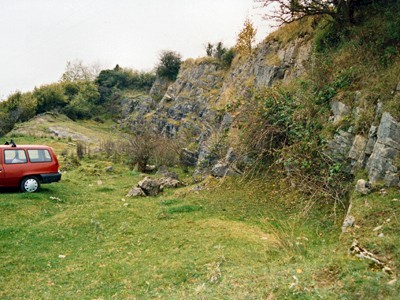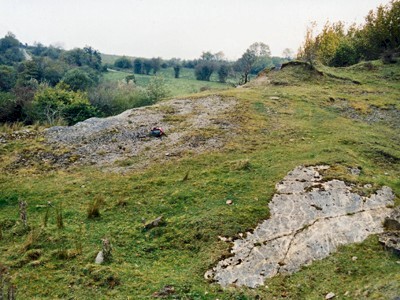Earth Science Conservation Review
| Cashel Quarry - Carboniferous | Fermanagh |
| Site Type: | Quarry (disused) |
| Site Status: | ASSI |
| Council area: | Fermanagh District Council |
| Grid Reference: | G979474 |
| Google maps: | 54.37571,-8.03229 |
| Rocks | |
|---|---|
| Rock Age: | Carboniferous (Asbian, Visean) |
| Rock Name: | Dartry Limestone Formation |
| Rock Type: | Limestone |
| Interest | |
| Minerals: | Micrite |
| Fossil Groups: | Brachiopod, Coral, Goniatite, Nautiloid, Trilobite |
| Other interest: | palaeokarst, Marine sediments |
Summary of site:
. There is a genuine mystery associated with this quarry. It brings together fossils that should be separated by at least 8 million years.
The quarry presents a sequence of 12m of strata very near the top of the Dartry Limestone Formation. The great bulk of the rocks are limestones consisting of cemented grains. They have been considerably disrupted, largely due to their emergence above sea level where they appear to have been deeply weathered and eroded. They were then re-submerged and erosion channels were filled with later limestones. Later still the rocks were dolomitized (when some of the calcium is replaced by magnesium, coarsening the rock and eliminating some original detail).
But the main interest in the quarry is the lowest half metre of rock which forms its sloping floor. The top 10cm are karstified (a process in which limestones are chemically eroded by acid waters, usually well above the water table). In this case the process resulted in a loose surface of angular fragments that was submerged. On top of this surface is a shale (originally fine mud), full of invertebrate fossils, many with a fine lime coating caused by exposure to encrusting algae. The commonest are horn-shaped corals, averaging 8cm in length, but there are also goniatites, lamp shells (brachiopods), nautiloids and trilobites. Corals, brachiopods and goniatites can all be used to date rocks if the species present have short time ranges, and this is where this fauna has proved enigmatic.
The Dartry Limestone is indisputably part of the Asbian stage, a well defined time interval. The goniatite fauna found in the quarry, while sparse, is varied with seven genera present, confirming absolutely that the rocks date from towards the end of this stage, around 337 million years ago. However, the horn corals have been tentatively identified as Sychnoelasma, a genus confined to the Chadian and early Arundian stages. The time interval between the early Arundian and the late Asbian is around 8 million years. The chances of a well known species surviving such a time interval undiscovered are remote.
So how does one explain this mystery? There is a possibility that the coral genus has been misidentified for a later and rarer but similar species such as Rylstonia, which is broadly the right age. But a further complication is the later discovery of a coral colony of the species Michelinia megastoma, similar in age to Sychnoelasma and possibly even older, returning the dilemma to square one.
A second possibility is that the earlier fossils were weathered out of Chadian or Arundian rocks during the Asbian and became incorporated into the Dartry Limestone, in other words they are derived fossils. There are two problems with this interpretation: first, the corals are well preserved, with little sign of weathering or rolling on the sea bed; and second, there are no older rocks nearby from which to derive them. So the enigma remains.
The concentration of interest in this quarry - the palaeokarst, the dolomitization, but particularly its rich and perplexing fauna - make it uniquely important. It should therefore be protected for future examination and research.
The corals in this quarry are prolific and preserved uncrushed in the shale. Since the full report was written, the floor of the quarry has been systematically stripped of every evident fossil, detracting from its value as a teaching and research site. Such irresponsible collecting must be condemned as a form of scientific vandalism. Fortunately a sample of the fauna is preserved in the collections of the Ulster Museum and the removal of a few substantial blocks should again reveal more of the shale and its remarkable fauna.
The site should be designated quickly and afforded proper protection.
The quarry presents a sequence of 12m of strata very near the top of the Dartry Limestone Formation. The great bulk of the rocks are limestones consisting of cemented grains. They have been considerably disrupted, largely due to their emergence above sea level where they appear to have been deeply weathered and eroded. They were then re-submerged and erosion channels were filled with later limestones. Later still the rocks were dolomitized (when some of the calcium is replaced by magnesium, coarsening the rock and eliminating some original detail).
But the main interest in the quarry is the lowest half metre of rock which forms its sloping floor. The top 10cm are karstified (a process in which limestones are chemically eroded by acid waters, usually well above the water table). In this case the process resulted in a loose surface of angular fragments that was submerged. On top of this surface is a shale (originally fine mud), full of invertebrate fossils, many with a fine lime coating caused by exposure to encrusting algae. The commonest are horn-shaped corals, averaging 8cm in length, but there are also goniatites, lamp shells (brachiopods), nautiloids and trilobites. Corals, brachiopods and goniatites can all be used to date rocks if the species present have short time ranges, and this is where this fauna has proved enigmatic.
The Dartry Limestone is indisputably part of the Asbian stage, a well defined time interval. The goniatite fauna found in the quarry, while sparse, is varied with seven genera present, confirming absolutely that the rocks date from towards the end of this stage, around 337 million years ago. However, the horn corals have been tentatively identified as Sychnoelasma, a genus confined to the Chadian and early Arundian stages. The time interval between the early Arundian and the late Asbian is around 8 million years. The chances of a well known species surviving such a time interval undiscovered are remote.
So how does one explain this mystery? There is a possibility that the coral genus has been misidentified for a later and rarer but similar species such as Rylstonia, which is broadly the right age. But a further complication is the later discovery of a coral colony of the species Michelinia megastoma, similar in age to Sychnoelasma and possibly even older, returning the dilemma to square one.
A second possibility is that the earlier fossils were weathered out of Chadian or Arundian rocks during the Asbian and became incorporated into the Dartry Limestone, in other words they are derived fossils. There are two problems with this interpretation: first, the corals are well preserved, with little sign of weathering or rolling on the sea bed; and second, there are no older rocks nearby from which to derive them. So the enigma remains.
The concentration of interest in this quarry - the palaeokarst, the dolomitization, but particularly its rich and perplexing fauna - make it uniquely important. It should therefore be protected for future examination and research.
The corals in this quarry are prolific and preserved uncrushed in the shale. Since the full report was written, the floor of the quarry has been systematically stripped of every evident fossil, detracting from its value as a teaching and research site. Such irresponsible collecting must be condemned as a form of scientific vandalism. Fortunately a sample of the fauna is preserved in the collections of the Ulster Museum and the removal of a few substantial blocks should again reveal more of the shale and its remarkable fauna.
The site should be designated quickly and afforded proper protection.
| Enlander, I., Dempster, M. & Doughty, P., 2025. Cashel Quarry - Carboniferous, County Fermanagh, site summary. [In] Earth Science Conservation Review. https://www.habitas.org.uk/escr/summary.php?item=187. Accessed on 2025-04-03 |
| Previous Site | Next Site |



